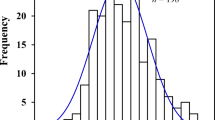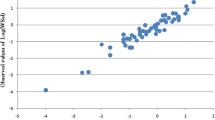Abstract
Solubility is a crucial limiting factor in pharmaceutical research and contaminated site remediation. Cyclodextrin, with its structure of hydrophilic exterior and hydrophobic cavity, has a potential ability to enhance the hydrophobic chemical’s solubility through the formation of host–guest complex. The stability of host–guest complex is often quantified by the inclusion constant. In this study, the logarithm of 1:1 α-cyclodextrin inclusion constants (log Kα) for 195 organic chemicals was collected. With this parameter as the endpoint, a quantitative structure–activity relationship (QSAR) model was developed using DRAGON descriptors and stepwise multiple linear regression analysis. The model statistics parameters indicated that the established model had a good determination coefficient of 0.857, a high cross-validation coefficient of 0.835, a low root mean square error of 0.380, together with the acceptable results of external validation, which indicate a satisfactory goodness-of-fit, robustness, and predictive ability of the model. Based on the screened eight descriptors, we propose an appropriate mechanism interpretation for the inclusion interaction. Additionally, the applicability domain of the current model was characterized by the Euclidean distance-based method and Williams plot, and results indicated that the model covered a large number of structurally diverse chemicals belonging to 13 different classes. Comparing with the previous reported models, this model has obvious advantages with a larger dataset, a higher value of correlation coefficient, and a wider application domain.





Similar content being viewed by others
References
Aalizadeh R, Pourbasheer E, Ganjali MR (2015) Analysis of B-Raf[Formula: see text] inhibitors using 2D and 3D-QSAR, molecular docking and pharmacophore studies. Mol Divers 19:915–930
Abraham MH, Acree WE (2010) Equations for the transfer of neutral molecules and ionic species from water to organic phases. J Organomet Chem 75:1006–1015
Adamo P, Iavazzo P, Albanese S, Agrelli D, De Vivo B, Lima A (2014) Bioavailability and soil-to-plant transfer factors as indicators of potentially toxic element contamination in agricultural soils. Sci Total Environ 500:11–22
Akita T, Yoshikiyo K, Yamamoto T (2014) Formation of 1:1 and 2:1 host–guest inclusion complexes of α-cyclodextrin with cycloalkanols: a 1H and 13C NMR spectroscopic study. J Mol Struct 1074:43–50
Alexander M (2000) Aging, bioavailability, and overestimation of risk from environmental pollutants. Environ Sci Technol 34:4259–4265
Alsbaiee A, Smith BJ, Xiao LL, Ling YH, Helbling DE, Dichtel WR (2016) Rapid removal of organic micropollutants from water by a porous beta-cyclodextrin polymer. Nature 529:190–194
áMartin Davies D, Deary ME, Wealleans DI (1998) Stability constants of α-cyclodextrin complexes of para-substituted aromatic ketones in aqueous solution. J Chem Soc Perkin Trans 2:193–196
Anselmi C, Centini M, Maggiore M, Gaggelli N, Andreassi M, Buonocore A, Beretta G, Facino RM (2008) Non-covalent inclusion of ferulic acid with alpha-cyclodextrin improves photo-stability and delivery: NMR and modeling studies. J Pharm Biomed 46:645–652
Babu NJ, Nangia A (2011) Solubility advantage of amorphous drugs and pharmaceutical cocrystals. Cryst Growth Des 11:2662–2679
Challa R, Ahuja A, Ali J, Khar RK (2005) Cyclodextrins in drug delivery: an updated review. AAPS PharmSciTech 6:E329–E357
Chamberlain RV II, Slowinska K, Majda M (2000) Electrostatically-induced inclusion of anions in cyclodextrin monolayers on electrodes. Langmuir 16:1388–1396
Che ZP, Zhang SY, Shao YH, Fan LL, Xu H, Yu X, Zhi XY, Yao XJ, Zhang R (2013) Synthesis and quantitative structure–activity relationship (QSAR) study of novel N-rylsulfonyl-3-acylindole arylcarbonyl hydrazone derivatives as nematicidal agents. J Agric Food Chem 61:5696–5705
Cui X, Mayer P, Gan J (2013) Methods to assess bioavailability of hydrophobic organic contaminants: principles, operations, and limitations. Environ Pollut 172:223–234
Davies DM, Deary ME (1995) Cooperativity and steric hindrance: important factors in the binding of α-cyclodextrin with para-substituted aryl alkyl sulfides, sulfoxides and sulfones. J Chem Soc Perkin Trans 2(7):1287–1294
Del Valle EMM (2004) Cyclodextrins and their uses: a review. Process Biochem 39:1033–1046
Eriksson L, Jaworska J, Worth AP, Cronin MTD, McDowell RM, Gramatica P (2003) Methods for reliability and uncertainty assessment and for applicability evaluations of classification- and regression-based QSARs. Environ Health Perspect 111:1361–1375
Estrada E, Perdomo-López I, Torres-Labandeira JJ (2001) Combination of 2D-, 3D-connectivity and quantum chemical descriptors in QSPR. Complexation of α-and β-cyclodextrin with benzene derivatives. J Chem Inf Comput Sci 41:1561–1568
Fechner U, Schneider G (2004) Optimization of a pharmacophore-based correlation vector descriptor for similarity searching. QSAR Comb Sci 23:19–22
Funasaki N, Ishikawa S, Neya S (2002) Solution structures of α-cyclodextrin complexes with propanol and propanesulfonate estimated from NMR and molecular surface area. J Phys Chem B 106:6431–6436
Ghasemi JB, Salahinejad M, Rofouei MK (2011) Review of the quantitative structure–activity relationship modelling methods on estimation of formation constants of macrocyclic compounds with different guest molecules. Supramol Chem 23:614–629
Ghasemi JB, Salahinejad M, Rofouei MK, Mousazadeh MH (2012) Docking and 3D-QSAR study of stability constants of benzene derivatives as environmental pollutants with α-cyclodextrin. J Incl Phenom Macro 73:405–413
Golbraikh A, Tropsha A (2002) Beware of q 2. J Mol Graph Model 20:269–276
Golbraikh A, Shen M, Xiao ZY, Xiao YD, Lee KH, Tropsha A (2003) Rational selection of training and test sets for the development of validated QSAR models. J Comput Aid Mol Des 17:241–253
Gramatica P, Papa E, Luini M, Monti E, Gariboldi MB, Ravera M, Gabano E, Gaviglio L, Osella D (2010) Antiproliferative Pt(IV) complexes: synthesis, biological activity, and quantitative structure–activity relationship modeling. J Biol Inorg Chem 15:1157–1169
Guo QX, Liu L, Cai WS, Jiang Y, Liu YC (1998a) Driving force prediction for inclusion complexation of a-cyclodextrin with benzene derivatives by a wavelet neural network. Chem Phys Lett 290:514–518
Guo QX, Luo SH, Liu YC (1998b) Substituent effects on the driving force for inclusion complexation of α- and β-cyclodextrin with monosubstituted benzene derivatives. J Incl Phenom Macro 30:173–182
Kawakami K (2012) Modification of physicochemical characteristics of active pharmaceutical ingredients and application of supersaturatable dosage forms for improving bioavailability of poorly absorbed drugs. Adv Drug Deliv Rev 64:480–495
Kopecký F, Kopecká B, Kaclík P (2001) Solubility study of nimodipine inclusion complexation with α- and β-cyclodextrin and some substituted cyclodextrins. J Incl Phenom Macro 39:215–217
Lantz AW, Wetterer SM, Armstrong DW (2005) Use of the three-phase model and headspace analysis for the facile determination of all partition/association constants for highly volatile solute-cyclodextrin-water systems. Anal Bioanal Chem 383:160–166
Lantz AW, Rodriguez MA, Wetterer SM, Armstrong DW (2006) Estimation of association constants between oral malodor components and various native and derivatized cyclodextrins. Anal Chim Acta 557:184–190
Linden L, Goss KU, Endo S (2016) Exploring 3D structural influences of aliphatic and aromatic chemicals on alpha-cyclodextrin binding. J Colloid Interface Sci 468:42–50
Linden L, Goss KU, Endo S (2017) 3D-QSAR predictions for alpha-cyclodextrin binding constants using quantum mechanically based descriptors. Chemosphere 169:693–699
Liu L, Guo QX (1999) Novel prediction for the driving force and guest orientation in the complexation of R- and β-cyclodextrin with benzene derivatives. J Phys Chem B 103:3461–3467
Liu L, Li WG, Guo QX (1999) Association constant prediction for the inclusion of α-cyclodextrin with benzene derivatives by an artificial neural network. J Incl Phenom Macro 34:291–298
Liu HH, Cai XY, Chen JW (2013) Mathematical model for cyclodextrin alteration of bioavailability of organic pollutants. Environ Sci Technol 47:5835–5842
Liu HH, Yang XH, Lu R (2016) Development of classification model and QSAR model for predicting binding affinity of endocrine disrupting chemicals to human sex hormone-binding globulin. Chemosphere 156:1–7
Loftsson T, Brewster ME (2012) Cyclodextrins as functional excipients: methods to enhance complexation efficiency. J Pharm Sci 101:3019–3032
Lopata A, Darvas F, Stadler-Szóke Á, Szejtli J (1985) Quantitative structure–stability relationships among inclusion complexes of cyclodextrins I: Barbituric acid derivatives. J Pharm Sci 74:211–213
Loukas YL (2000) Radial basis function networks in host–guest interactions: instant and accurate formation constant calculations. Anal Chim Acta 417:221–229
Loukas YL (2001) Quantitative structure–binding relationships (QSBR) and artificial neural networks: improved predictions in drug: cyclodextrin inclusion complexes. Int J Pharm 226:207–211
Matsui Y, Mochida K (1979) Binding forces contributing to the association of cyclodextrin with alcohol in an aqueous solution. B Chem Soc Jpn 52:2808–2814
Mocelo-Castell R, Villanueva-Novelo C, Cáceres-Castillo D, Carballo RM, Quijano-Quiñones RF, Quesadas-Rojas M, Cantillo-Ciau Z, Cedillo-Rivera R, Moo-Puc RE, Moujir LM, Mena-Rejón GJ (2015) 2-Amino-4-arylthiazole derivatives as anti-giardial agents: synthesis, biological evaluation and QSAR studies. Open Chem 13:1127–1136
Mousset E, Oturan N, van Hullebusch ED, Guibaud G, Esposito G, Oturan MA (2014) Influence of solubilizing agents (cyclodextrin or surfactant) on phenanthrene degradation by electro-Fenton process—study of soil washing recycling possibilities and environmental impact. Water Res 48:306–316
Nishikawa S, Kondo M (2006) Kinetic study for the inclusion complex of carboxylic acids with cyclodextrin by the ultrasonic relaxation method. J Phys Chem B 110:26143–26147
OECD (2007) Guidance document on the validation of (quantitative) structure–activity relationships [(Q)SAR] models. Organisation for Economic Co-Operation and Development, Paris, France. <http://www.oecd.org/env/ehs/risk-assessment/guidancedocumentsandreportsrelatedtoqsars.htm>
Qiu XM, Sun DZ, Wei XL, Yin BL (2007) Thermodynamic study of the inclusion interaction between gemini surfactants and cyclodextrins by isothermal titration microcalorimetry. J Solut Chem 36:303–312
Ramstad T, Hadden CE, Martin GE, Speaker SM, Teagarden DL, Thamann TJ (2005) Determination by NMR of the binding constant for the molecular complex between alprostadil and alpha-cyclodextrin. Implications for a freeze-dried formulation. Int J Pharm 296:55–63
Rekharsky MV, Inoue Y (2002) Solvent and guest isotope effects on complexation thermodynamics of α-, β-, and 6-amino-6-deoxy-β-cyclodextrins. J Am Chem Soc 124:12361–12371
Schnur DM, Grieshaber MV, Bowen JP (1991) Development of an internal searching algorithm for parameterization of the MM2 MM3 force fields J. Comput Chem 12:844–849
Schuur JH, Selzer P, Gasteiger J (1996) The coding of the three-dimensional structure of molecules by molecular transforms and its application to structure–spectra correlations and studies of biological activity. J Chem Inf Comput Sci 36:334–344
Shariati-Rad M, Hasani M (2013) Linear and nonlinear quantitative structure–property relationships modeling of charge–transfer complex formation of organic donors with iodine and iodine monochloride using partial least squares and radial basis function–partial least squares. J Iran Chem Soc 10:1247–1256
Terekhova I, Chibunova E, Kumeev R, Alper G (2013) Role of biologically active inorganic anions Cl- and Br- in inclusion complex formation of α-cyclodextrin with some aromatic carboxylic acids. Chem Phys Lett 557:134–139
Wan Yunus WMZ, Taylor J, Bloor DM, Hall DG, Wyn-Jones E (1992) Electrochemical measurements on the binding of sodium dodecyl sulfate and dodecyltrimethylammonium bromide with α- and β-cyclodextrins. J Phys Chem 96:8979–8982
Wei WH, Chu YQ, Ding CF (2014) Gas-phase binding of noncovalent complexes between α-cyclodextrin and amino acids investigated by mass spectrometry. Anal Lett 47:2221–2237
Williams HD, Trevaskis NL, Charman SA, Shanker RM, Charman WN, Pouton CW, Porter CJH (2013) Strategies to address low drug solubility in discovery and development. Pharmacol Rev 65:315–499
Acknowledgements
The study was supported by the National Natural Science Foundation of China (No. 21507061, No. 21507038, and No. 41671489) and the Natural Science Foundation of Jiangsu Province (No. BK20150771).
Author information
Authors and Affiliations
Corresponding authors
Ethics declarations
Conflict of interest
The authors declare that they have no conflict of interest.
Transparency document
The transparency document associated with this article can be found in the online version.
Additional information
Responsible editor: Marcus Schulz
Electronic supplementary material
ESM 1
(DOCX 226 kb)
Rights and permissions
About this article
Cite this article
Wei, M., Yang, X., Watson, P. et al. Development of QSAR model for predicting the inclusion constants of organic chemicals with α-cyclodextrin. Environ Sci Pollut Res 25, 17565–17574 (2018). https://doi.org/10.1007/s11356-018-1917-2
Received:
Accepted:
Published:
Issue Date:
DOI: https://doi.org/10.1007/s11356-018-1917-2




